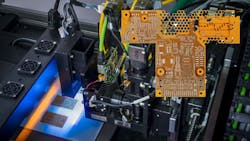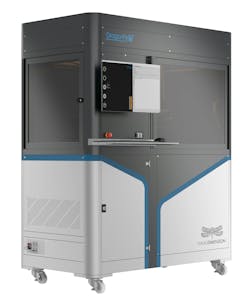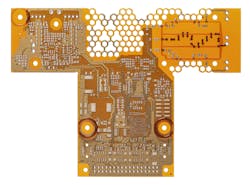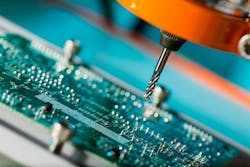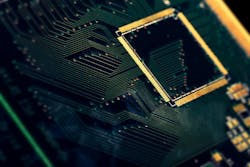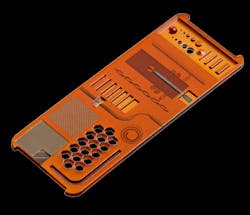Additive Manufactured Electronics: Disrupting the Electronics Industry
What you’ll learn:
- Why does AME continue to capture the gaze of the electronics industry?
- What challenges does AME address and overcome?
Additive manufactured electronics (AME) brings significant advantages such as increased functionality and design flexibility to developers. Devices like 3D printers are just one way to incorporate AME into product creation. Most engineers know about single-material 3D printing, but the technology is more advanced and varied with the ability to include things like conductive and dielectric materials.
I talked with Zvika Alon, General Manager AME at Nano Dimension, to get more insight into how AME is being used. Also discussed is the company’s DragonFly 3D printers, which can handle multiple materials (Fig. 1).
Can you first start by giving us a brief overview of who Nano Dimension is, and what it is you do?
Sure. We are a provider of additively manufactured electronics technology. We manufacture 3D printers that enable an alternative in-house method of designing, developing, and manufacturing high-performance electronic devices (Hi-PEDs) and PCBs. We also manufacture 3D printing solutions for the production of ceramic and specialty polymer-based applications, from millimeters to several centimeters in size with micron precision.
Our hardware, software, material, and process holistic solutions are specially tuned today to our customers in R&D, spanning aerospace and defense, medical, industrial products, and scientific research. Our goal is to provide industrial-grade solutions that enable high-mix, low-volume production. We closely partner with our customers to get there and already have customers that use our solutions for high-mix, low-volume production of selected applications in AME, ceramics, and micro-polymers.
Why does AME continue to capture the gaze of the electronics industry, and what challenges does it specifically address and overcome?
I think this broadly breaks down into three areas. First, it’s the ability to leverage 3D-printing technology to open up the in-house rapid prototyping of parts, especially complex small devices such as antennas, sensors, and connectors. It will be complex and sometimes not possible to iterate in a timely and economical manner with traditional prototyping methods. With AME, though, it is a seamless effort that allows you to run agile HW development projects.
This enables the creation of more advanced products via greater freedom of design through geometry—that’s to say make products smarter and smaller and with integrated non-planar electronics. Today, designers can simultaneously 3D-print conductive and dielectric material to produce completely new designs, including integrated printed components such as twisted coils, capacitors, and any angle connection of conductors (Fig. 2). These capabilities simplify the assembly steps and improve signal integrity.
Second is the ability to 3D-print fast, cost-effective, multi-layer prototype PCBs. While PCB prototyping is achievable via traditional means (i.e., sending the design to PCB manufacture), doing it in-house with AME accelerates product development, eliminates dependency on external vendors, shortens lead times, and allows for the simultaneous printing of multiple designs (Fig. 3). This enables the creation of functional prototypes faster than any other method and shortens time-to-market.
Third, it’s the opportunity to reshore production and use digital inventories for in-the-field creation of electronics spare parts. Logically, this is hugely advantageous, but especially so if sudden unforeseen geopolitical or other events have impacted the normal supply chains. This capability also lessens the dependency on China.
OK, so essentially, in terms of the benefits it delivers for prototyping of designs, AME is not that different to standard 3D printing, which is now a firmly established technology choice for other industry sectors?
Yes, that’s a fair analysis, but the difference with AME is that the market is still acquainting itself with those benefits. So, despite there being huge advantages in the way it streamlines the prototyping process and removes the hassle and complexities, it naturally takes time for design engineers to properly understand, appreciate, and ultimately adopt an alternative technology proposition rather than the established process with which they are extremely familiar (Fig. 4).
With AME, we are today where we were a few years ago with what I refer to as “mechanical” 3D printing or AM. And, as 3D printing is now the go-to technology for those designers—who would never consider going back to the laborious, complicated, and costly traditional prototyping methods—no doubt we will continue to see more and more electronics industry designers recognize AME for the transformative technology that it is.
What are you doing to drive that education within the industry and accelerate the adoption of AME within the market?
One challenge we have with this technology is the need to build the market and the people for it, because nobody has learned how to design for 3D-printed electronics. As part of our strategy to address this, we are working with numerous universities and research institutes to explore and find use cases for AME.
With this collaboration, we are, together with the University of Stuttgart and the BMBF Cluster4Future Qsens, already utilizing the multi-layer, multi-material DragonFly IV 3D printer to accelerate innovation in the field of quantum devices.
Additionally, we are working with the global organization for electronics manufacturing, IPC, to create IPC Standard 2581—a dedicated standard for the qualification and production of 3D printed electronics.
That sounds interesting. Can you tell us more about it?
Quite simply, we believe that solutions providers like us need to instill trust in the AME offering. We have donated our internal procedures to launch the IPC standardization effort and have provided a recognized industry expert to lead the AME subcommittee and specific task groups.
The aim is to develop an industry-wide qualification and acceptability standard, along with test methods and design guidelines based on reliability requirements that are globally accepted by consumers of AME products. Importantly, for OEMs and manufacturers, the standard will provide evidence-based requirements to ensure production of reliable AME regardless of the manufacturing location.
So, what sorts of applications can we expect in the future and how far out are we from seeing them?
I think we can soon expect some breakthrough developments in the way AME is used, some of it being exemplified by companies that we’re working with who are developing products that can only be created with AME (Fig. 5). One such company is a German startup that’s using our technology to create microneedles for the development of pacemakers that are powered by the energy of your body. So, once inserted, you would never need to change the battery because your body’s biological cells harvest electrical energy needed to power it.
We also see strong potential within applications like micro drones, where structural parts and electronic parts could be integrated together to save weight and space. There are also various radio-frequency applications in which AME could play a significant role.
Ultimately, it really depends on the application and the industry. We are perhaps only a year or two away from seeing 3D-printed electronics in one-time-use-only devices for certain military applications. We are maybe five years out from seeing AME in a military aircraft, and I believe around 10 years away from parts in civil aircraft.
Clearly exciting times ahead then. Are there any other predictions you would like to offer in conclusion?
I can see a steady convergence of electronic and mechanical design. Where we currently have separate departments for mechanical design, electrical design, and software, I believe that we’ll soon just have hardware and software departments.
Also, for Nano Dimension and other manufacturers like us, materials and processes, along with software, will be key. But fundamentally, as I mentioned, we are still in the market education phase, just as those pioneers of mechanical 3D printing were around 30 years. And as the last few decades have proven, the acceptance of that technology as a design solution and more recently as a viable manufacturing option for industry is now commonplace.
Indeed, within automotive, aerospace, mobility, or elsewhere, no company that has embraced 3D printing for their design-for-manufacturing requirements would ever revert to traditional prototyping or production methods. Likewise, in due course, the same will be true when it comes to the embrace and integration of AME among the electronics industry.
About the Author
William G. Wong
Senior Content Director - Electronic Design and Microwaves & RF
I am Editor of Electronic Design focusing on embedded, software, and systems. As Senior Content Director, I also manage Microwaves & RF and I work with a great team of editors to provide engineers, programmers, developers and technical managers with interesting and useful articles and videos on a regular basis. Check out our free newsletters to see the latest content.
You can send press releases for new products for possible coverage on the website. I am also interested in receiving contributed articles for publishing on our website. Use our template and send to me along with a signed release form.
Check out my blog, AltEmbedded on Electronic Design, as well as his latest articles on this site that are listed below.
You can visit my social media via these links:
- AltEmbedded on Electronic Design
- Bill Wong on Facebook
- @AltEmbedded on Twitter
- Bill Wong on LinkedIn
I earned a Bachelor of Electrical Engineering at the Georgia Institute of Technology and a Masters in Computer Science from Rutgers University. I still do a bit of programming using everything from C and C++ to Rust and Ada/SPARK. I do a bit of PHP programming for Drupal websites. I have posted a few Drupal modules.
I still get a hand on software and electronic hardware. Some of this can be found on our Kit Close-Up video series. You can also see me on many of our TechXchange Talk videos. I am interested in a range of projects from robotics to artificial intelligence.
